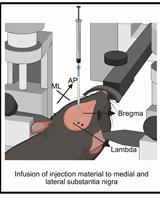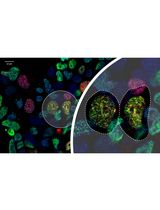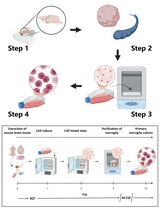- EN - English
- CN - 中文
α-Synuclein Aggregation Monitored by Thioflavin T Fluorescence Assay
通过硫磺素T荧光测定法监测核突触蛋白聚集
发布: 2018年07月20日第8卷第14期 DOI: 10.21769/BioProtoc.2941 浏览次数: 14873
评审: Ralph Thomas BoettcherAditya IyerAnonymous reviewer(s)

相关实验方案

基于 rAAV-α-Syn 与 α-Syn 预成纤维共同构建的帕金森病一体化小鼠模型
Santhosh Kumar Subramanya [...] Poonam Thakur
2025年12月05日 1406 阅读
Abstract
Studying the aggregation of amyloid proteins like α-synuclein in vitro is a convenient and popular tool to gain kinetic insights into aggregation as well as to study factors (e.g., aggregation inhibitors) that influence it. These aggregation assays typically make use of the fluorescence dye Thioflavin T as a sensitive fluorescence reporter of amyloid fibril formation and are conducted in a plate-reader-based format, permitting the simultaneous screening of multiple samples and conditions. However, aggregation assays are generally prone to poor reproducibility due to the stochastic nature of fibril nucleation and the multiplicity of modulating factors. Here we present a simple and reproducible protocol to study the aggregation of α-synuclein in a plate-reader based assay.
Keywords: Amyloid (淀粉样蛋白)Background
Aggregation of endogenous proteins to amyloid fibrils is a pathogenic process that is associated with several disorders, e.g., neurodegenerative diseases like Alzheimer’s disease (AD) or Parkinson’s disease (PD) as well as systemic diseases like AL amyloidosis (Knowles et al., 2014). This process can be recapitulated in vitro in a plate-reader-based setup by aggregation assays based on Thioflavin T fluorescence, allowing the aggregation kinetics of amyloid proteins to be studied in dependence of various influencing factors.
Thioflavin T (ThT) is a fluorescence dye that has first been used for staining amyloid fibrils in histological samples by Vassar and Culling in 1959 (Vassar and Culling, 1959), its application for detecting and quantifying amyloid fibrils in vitro has first been described by Naiki et al. in 1989 (Naiki et al., 1989). Upon binding within the cross-β-architecture of amyloid fibrils, ThT changes its spectral characteristics (bathochromic wavelength shift to λex: 450 nm and λem: 482 nm) and exhibits a strong increase in fluorescence emission (Biancalana and Koide, 2010). It is therefore a very sensitive indicator of amyloid fibril formation and has been adapted to aggregation assays with synthetically and recombinantly produced amyloidogenic proteins, like the AD-associated protein amyloid-β (LeVine, 1993) as well as the PD-associated protein α-synuclein (Hashimoto et al., 1998).
Aggregation assays with Thioflavin T are nowadays mainly performed in fluorescence plate readers, where e.g., 96 conditions can be tested simultaneously. These assays suffer from poor reproducibility resulting from the stochastic nature of fibril nucleation and the multiplicity of factors affecting protein aggregation. Therefore, strategies to increase the reproducibility of ThT assays have been employed, such as the use of orbital shaking of the well plate during the measurement as well as the addition of glass beads to the wells to improve mixing (Giehm and Otzen, 2010).
Here, we describe a simple protocol for α-synuclein aggregation assays using ThT that comprises the following strategies to improve reproducibility and convenience:
- The use of N-terminally acetylated α-synuclein, which is the native state of the protein (Anderson et al., 2006). N-terminal acetylation of α-synuclein also increases reproducibility of aggregation half times in ThT assays (Iyer et al., 2016).
- Thirty seconds of shaking prior to the ThT fluorescence measurement leads to more reproducible fluorescence readings due to a more homogenous distribution of fibrils within the sample, including aggregation nuclei that preferentially form at the air-water-interface (Campioni et al., 2014).
- Glass beads (Ø 2.85-3.45 mm) are added to each well to improve mixing and homogeneity of the sample as described (Giehm and Otzen, 2010).
- We use half-area 96-well-plates (Corning, USA) that have a non-binding surface. Half-area wells save sample volume, as only 100-120 μl is needed per well. The non-binding surface e.g., prevents adsorption of amyloid fibrils to the well surface, a process that can cause aberrant readings in ThT assays (Murray et al., 2013).
Materials and Reagents
- 50 ml Falcon centrifuge tubes (TPP Techno Plastic Products, catalog number: 91050 )
- Sterile syringe filter, Filtropur S, 0.2 μm (SARSTEDT, catalog number: 83.1826.001 )
- Slide-A-LyzerTM dialysis cassettes 10 kDA MW cutoff, 3-12 ml (Thermo Fisher Scientific, catalog number: 66810 )
- HiTrap Q HP IEC column, 5 ml (GE Healthcare, catalog number: 17115401 )
- Superdex 75 16/60 SEC column, ~120 ml volume (GE Healthcare, catalog number: 28989333 )
- Protein LoBind Tubes 1.5 ml (Eppendorf, catalog number: 0030108116 )
- 96-well plates (Corning half-area, black and clear flat bottom, non-binding surface) (Corning, catalog number: 3881 )
- Sealing tape, clear polyolefin (Thermo Fisher Scientific, catalog number: 232701 )
- E. coli BL21DE3 competent cells (e.g., available from Merck, catalog number: 69450 )
- α-Synuclein in pT7-7 vector (e.g., Addgene, catalog number: 36046 )
We use a version of this plasmid that is codon-optimized for E. coli - NatB in pACYCduet vector (e.g., Addgene, catalog number: 53613 )
- Isopropyl β-D-1-thiogalactopyranoside (IPTG), > 99% (Ubiquitin-Proteasome Biotechnologies, catalog number: P1010-100 )
- Ampicillin sodium salt (Sigma-Aldrich, catalog number: A9518 )
- Chloramphenicol (Sigma-Aldrich, catalog number: C0378 )
- YT medium (2x) premixed powder (AppliChem, catalog number: A0981 )
- Magnesium sulfate heptahydrate p.a. (Merck, catalog number: 1058860500 )
- Glycerol bidistilled, ≥ 99.5% (VWR, catalog number: 24388 )
- Tris(hydroxymethyl)aminomethane, Trizma base p.a. (Sigma-Aldrich, catalog number: 93350 )
- Sodium chloride, p.a. (Carl Roth, catalog number: 3957 )
- Sodium dihydrogen phosphate monohydrate, p.a. (AppliChem, catalog number: 131965.1211 )
- α-Synuclein, N-terminally acetylated (from recombinant expression in E. coli [Johnson et al., 2010] and purified as described [Wördehoff et al., 2017])
Note: We verify N-terminal acetylation by HPLC and mass spectrometry. Alternatively, acetic acid gel electrophoresis can be performed (Iyer et al., 2016). We have included a short description of our α-synuclein purification protocol in the procedure section of this protocol. - Thioflavin T, ultrapure grade (AnaSpec, catalog number: AS-88306 )
- Sodium azide (purum p.a., Sigma-Aldrich, catalog number: 71290 )
- H2O (Milli-Q ≥ 18.2 MΩ resistivity)
- Glass beads, Ø 2.85-3.45 mm (Carl Roth, catalog number: A557.1 ), stored in 70% ethanol to ensure sterility
- Potassium dihydrogen phosphate (p.a., AppliChem, catalog number: A1043 )
- Dipotassium hydrogen phosphate, trihydrate (p.a., Merck, catalog number: 105099 )
- Potassium chloride (p.a., Carl Roth, catalog number: 6781.1 )
- Hydrochloric acid, p.a. ≥ 37% (Sigma-Aldrich, catalog number: 30721-M )
- Ammonium sulfate, puriss. p.a. ≥ 99% (Merck, catalog number: 31119-M )
- Modified 2YT medium (see Recipes)
- 10x Medium buffer, pH 7.2 (see Recipes)
- IEC buffer A (see Recipes)
- IEC buffer B (see Recipes)
- Saturated ammonium sulfate solution (see Recipes)
- SEC buffer (see Recipes)
Equipment
- Pipettes (e.g., Eppendorf, model: Research® Plus , catalog numbers: 3123000039, 3123000055, 3123000063)
- Sterile tweezers
- -80 °C freezer
- Fluorescence plate reader (e.g., BMG LABTECH, model: FLUOstar Omega ), equipped with monochromators or appropriate filters for the fluorophore Thioflavin T (e.g., BMG excitation filter: 448(nm)-10, BMG emission filter: 482(nm)-10)
Note: The plate reader should be heatable to 37 °C. - UV/VIS spectrophotometer (e.g., JASCO, model: V-650 )
- Heating Block (e.g., Grant Instruments, model: UBD2 )
- Magnetic stirrer (e.g., Cole-Parmer Instrument, Stuart, model: CB161 )
- Centrifuge for 50 ml Falcons (e.g., Eppendorf, model: 5804 R )
- ÄKTA Purifier (GE Healthcare)
Software
- Microsoft Excel
- AmyloFit (http://www.amylofit.ch.cam.ac.uk/)
Procedure
文章信息
版权信息
© 2018 The Authors; exclusive licensee Bio-protocol LLC.
如何引用
Wördehoff, M. M. and Hoyer, W. (2018). α-Synuclein Aggregation Monitored by Thioflavin T Fluorescence Assay. Bio-protocol 8(14): e2941. DOI: 10.21769/BioProtoc.2941.
分类
分子生物学 > 蛋白质 > 蛋白质-蛋白质相互作用
神经科学 > 神经系统疾病 > 帕金森氏症
生物化学 > 蛋白质 > 自组装
您对这篇实验方法有问题吗?
在此处发布您的问题,我们将邀请本文作者来回答。同时,我们会将您的问题发布到Bio-protocol Exchange,以便寻求社区成员的帮助。
Share
Bluesky
X
Copy link












